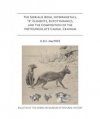![The Serrialis Bone, Interparietals, “X” Elements, Entotympanics, and the Composition of the Notoungulate Caudal Cranium The Serrialis Bone, Interparietals, “X” Elements, Entotympanics, and the Composition of the Notoungulate Caudal Cranium]()
Click to have a closer look
About this book
Related titles
About this book
The composition of the caudal cranium in Notoungulata, an extinct group of endemic South American "ungulates," has never been properly clarified. Some investigators have claimed that so-called "adventitious" elements, or elements not known to occur in other placentals, existed in the auditory regions of certain typotheres and toxodontians. Others have disputed this, arguing that sutures or other indicia that supposedly provide evidence of the developmentally independent origins of these alleged ossifications are either misinterpreted or inconstant.
The Serrialis Bone, Interparietals, “X” Elements, Entotympanics, and the Composition of the Notoungulate Caudal Cranium attempts to resolve the question of composition, as far as it is possible to do in the case of a wholly extinct clade, with detailed micro-CT investigations of several key taxa, including Oldfieldthomasia (Oldfieldthomasiidae), Paedotherium (Hegetotheriidae), and Cochilius (Interatheriidae). Results show that Santiago Roth was incorrect in asserting that certain notoungulates, such as pachyrukhine hegetotheres, possessed cranial elements (serrialis, posttympanicum, etc.) that are unrepresented in other placentals. George Gaylord Simpson also thought Roth was wrong, but erred in claiming to have discovered concrete evidence of two other ossifications, denoted by him as Xa and Xp, in the auditory region of Oldfieldthomasia. In adult notoungulates the interparietal complex is usually fused with the parietal, or supraoccipital, or both elements.
As in certain other mammals, dorsal exposure of the supraoccipital is limited in notoungulates because it is often overplated by the interparietal complex, which thus provides a sort of "second" roof for the caudal cranium. However, there is no interparietal involvement in the middle ear cavity. Finally, for the first time plausible grounds can be offered for the existence of an entotympanic in a notoungulate (Cochilius). Evidence is increasing for the proposition that entotympanics are much more widespread than previously thought, and may in fact be present in most of the major groups of placentals. In summary, this study shows that in terms of participating elements there is nothing unique about the notoungulate caudal cranium, which was evidently as tightly constrained compositionally as it is in other placentals.
Nevertheless, this portion of the skull, still notably underutilized in notoungulate studies, could be a crucial source of new characters for assessing higher-level relationships not only among notoungulates, but also among South American ungulates and their possible relatives.
Customer Reviews









































